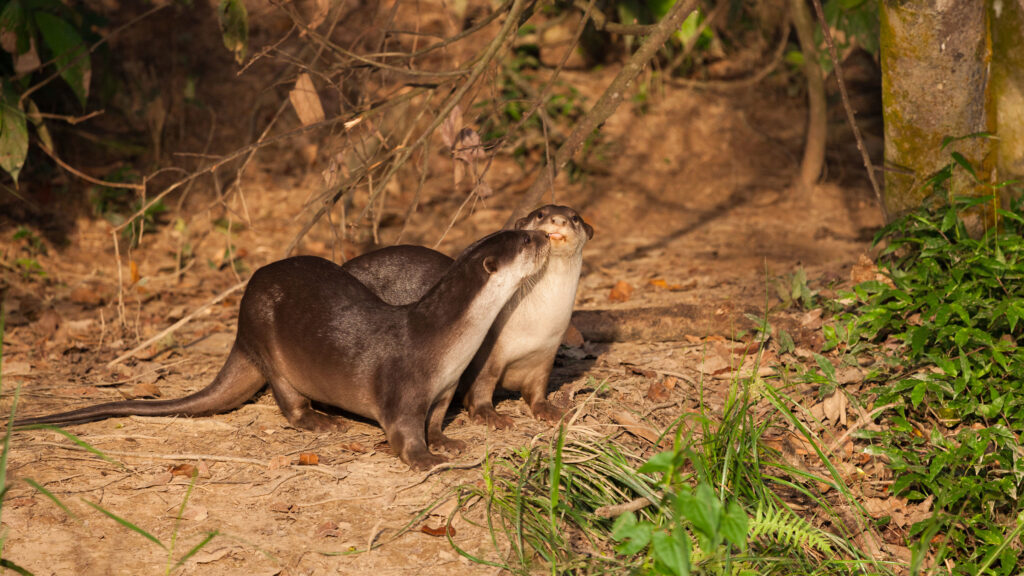
In a captivating turn of events, wildlife photographer Milan Tamang stumbled upon a hidden gem in Nepal’s Chitwan National Park on September 10—an elusive smooth-coated otter in the Rapti River. The species, absent from records for over two decades, surfaced behind the tall white grass that flourished after the monsoon.
Caught off guard without his camera, Tamang relied on his phone to immortalize the otter’s presence, especially captivated as it gracefully swam in the river. Curiosity sparked by a friend’s mention of a potential otter sighting in the area led Tamang to share the images with experts in Chitwan and Kathmandu. Their unanimous confirmation identified the creature as a smooth-coated otter (Lutrogale perspicillata), sparking intrigue and concern about its status in the national park.
This rare encounter amplifies the challenges faced by the three otter species in Nepal, battling threats from habitat loss, river pollution due to hydropower development, sand mining, and agricultural runoff. Conservationists are now rallying for funding to deploy camera traps along the Rapti River, emphasizing the importance of monitoring and safeguarding the otter population.
As the photographic tale unfolds, Paras Mani Acharya, a seasoned otter researcher, reminisces about the last documented otter sightings in the Rapti in 1998 during a study employing camera traps. The reemergence of these creatures in the lens of Milan Tamang’s phone raises both excitement and questions, urging a renewed focus on the conservation efforts in Chitwan National Park.

Nepal is thought to be home to three otter species: the smooth-coated otter, the Eurasian otter (Lutra lutra), and the Asian small-clawed otter (Aonyx cinerea). While the Eurasian otter is distributed in mountain streams, rivers and lakes, the smooth-coated otter is believed to be present in the major rivers of Nepal: the Narayani, Koshi, Karnali and Mahakali. The small-clawed otter hasn’t been documented in the country since 1839. The latter two species are listed as vulnerable on the IUCN Red List, while the Eurasian otter is considered near-threatened.
Otters are usually found in groups called parties, said researcher Sanjan Thapa from the Small Mammals Conservation and Research Foundation. Thapa, one of the experts who positively identified the animal in Tamang’s photos as a smooth-coated otter, said they’re not typically known to roam solitarily. Why this individual was spotted alone, he said, is a question only further research can answer. Tamang suggested this could be due to the poor state of health of the river.
The IUCN, the global conservation authority, says the species’ natural habitats are being destroyed due to infrastructure development such as the construction of large-scale hydropower plants and reclamation of wetlands for settlements and agriculture. It also cites threats from agricultural runoff polluting rivers, endangering not just the otter populations but also the fish they feed on. These problems persist in various forms across the range of the smooth-coated otter, from Iraq in the west to Indonesia in the east.
Bed Kumar Khadka, a conservationist who worked in Chitwan for the Department of National Park and Wildlife Conservation, said the disappearance of otters from the Rapti River and the sighting of just a single individual suggests that disturbances such as sand mining and overfishing in the river continue to affect the species.
“We can easily spot smooth-coated otters in Bardiya National Park, where the Karnali River is still relatively pristine,” he added.
Nepal has invested heavily in hydropower over the past few decades, with the aim of exporting electricity to neighboring countries such as India, Bangladesh and even China. Hydropower developers have frequently violated requirements for how much water to release from their dams during the dry season to help sustain biodiversity downstream. Similarly, sand mining has become a lucrative business, with the government failing to regulate and monitor the industry. Waste from the mining process is dumped into rivers, turning the water turbid.
Despite the multitude of challenges otters face in Nepal, none of the three species was granted protected status under the National Parks and Wildlife Conservation Act when it came out in 1973. Since then, however, the Eurasian otter and smooth-coated otter have gained protection under a 2002 amendment to the Aquatic Life Protection Act of 1961.
Another question that the sighting of the smooth-coated otter in Chitwan raises is why conservation agencies aren’t investing more resources on otter research in the park, said conservationist Rama Mishra. Her team recorded the species in another protected area, Koshi Tappu Wildlife Reserve, in 2021, more than two decades after they were last seen there.
“We need to install camera traps [in Chitwan] right away and observe the individual’s movement,” Mishra added.
Nepal’s wildlife department and conservation NGOs have often been accused of prioritizing the conservation of the country’s more charismatic species, such as tigers and rhinos, with the bulk for their funding going to these animals. Smaller, less prominent species such as otters are never a priority, Mishra said.
Some conservationists say they believe the otters never disappeared entirely from the Chitwan stretch of the Rapti.
“We can’t say that they are not there, just because we haven’t looked for them properly,” Acharya said. “The last time we did a camera trap survey was back in 1998. So many years have passed, but we haven’t looked for them again.”
